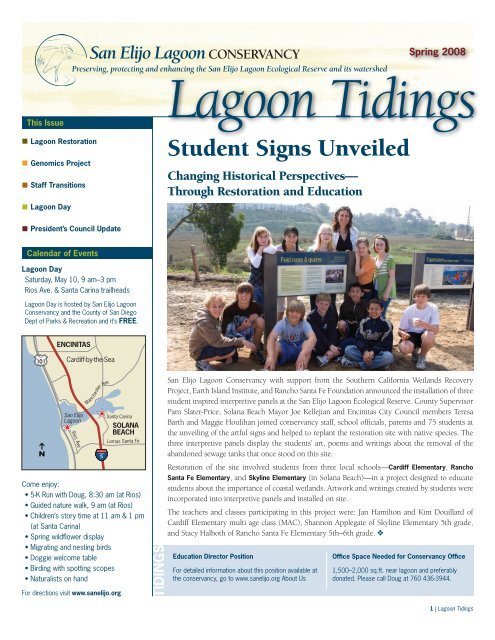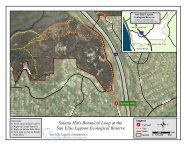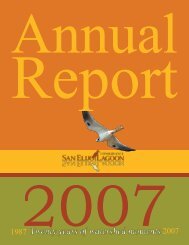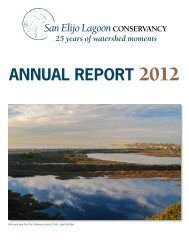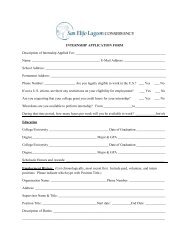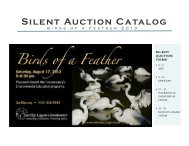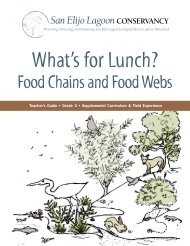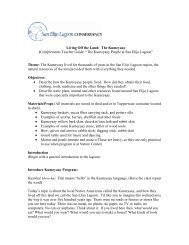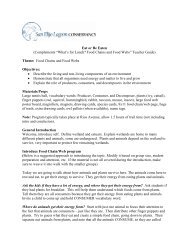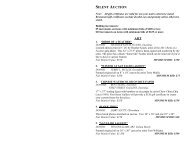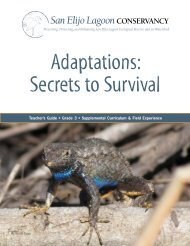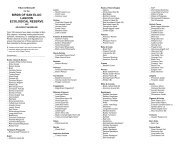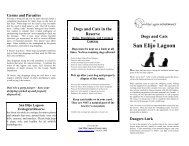Spring - San Elijo Lagoon Conservancy
Spring - San Elijo Lagoon Conservancy
Spring - San Elijo Lagoon Conservancy
You also want an ePaper? Increase the reach of your titles
YUMPU automatically turns print PDFs into web optimized ePapers that Google loves.
This Issue<br />
<strong>Lagoon</strong> Restoration<br />
Genomics Project<br />
Staff Transitions<br />
<strong>Lagoon</strong> Day<br />
<strong>San</strong> <strong>Elijo</strong> <strong>Lagoon</strong> CONSERVANCY<br />
Preserving, protecting and enhancing the <strong>San</strong> <strong>Elijo</strong> <strong>Lagoon</strong> Ecological Reserve and its watershed<br />
<strong>Lagoon</strong> Tidings<br />
Student Signs Unveiled<br />
Changing Historical Perspectives—<br />
Through Restoration and Education<br />
<strong>Spring</strong> 2008<br />
President’s Council Update<br />
Calendar of Events<br />
<strong>Lagoon</strong> Day<br />
Saturday, May 10, 9 am–3 pm<br />
Rios Ave. & <strong>San</strong>ta Carina trailheads<br />
<strong>Lagoon</strong> Day is hosted by <strong>San</strong> <strong>Elijo</strong> <strong>Lagoon</strong><br />
<strong>Conservancy</strong> and the County of <strong>San</strong> Diego<br />
Dept of Parks & Recreation and it’s FREE.<br />
<strong>San</strong> <strong>Elijo</strong> <strong>Lagoon</strong> <strong>Conservancy</strong> with support from the Southern California Wetlands Recovery<br />
Project, Earth Island Institute, and Rancho <strong>San</strong>ta Fe Foundation announced the installation of three<br />
student inspired interpretive panels at the <strong>San</strong> <strong>Elijo</strong> <strong>Lagoon</strong> Ecological Reserve. County Supervisor<br />
Pam Slater-Price, Solana Beach Mayor Joe Kellejian and Encinitas City Council members Teresa<br />
Barth and Maggie Houlihan joined conservancy staff, school officials, parents and 75 students at<br />
the unveiling of the artful signs and helped to replant the restoration site with native species. The<br />
three interpretive panels display the students’ art, poems and writings about the removal of the<br />
abandoned sewage tanks that once stood on this site.<br />
Come enjoy:<br />
• 5-K Run with Doug, 8:30 am (at Rios)<br />
• Guided nature walk, 9 am (at Rios)<br />
• Children’s story time at 11 am & 1 pm<br />
(at <strong>San</strong>ta Carina)<br />
• <strong>Spring</strong> wildflower display<br />
• Migrating and nesting birds<br />
• Doggie welcome table<br />
• Birding with spotting scopes<br />
• Naturalists on hand<br />
For directions visit www.sanelijo.org<br />
TIDINGS<br />
Restoration of the site involved students from three local schools—Cardiff Elementary, Rancho<br />
<strong>San</strong>ta Fe Elementary, and Skyline Elementary (in Solana Beach)—in a project designed to educate<br />
students about the importance of coastal wetlands. Artwork and writings created by students were<br />
incorporated into interpretive panels and installed on site.<br />
The teachers and classes participating in this project were: Jan Hamilton and Kim Douillard of<br />
Cardiff Elementary multi age class (MAC), Shannon Applegate of Skyline Elementary 5th grade,<br />
and Stacy Halboth of Rancho <strong>San</strong>ta Fe Elementary 5th–6th grade. v<br />
Education Director Position<br />
For detailed information about this position available at<br />
the conservancy, go to www.sanelijo.org About Us<br />
Office Space Needed for <strong>Conservancy</strong> Office<br />
1,500–2,000 sq.ft. near lagoon and preferably<br />
donated. Please call Doug at 760 436-3944.<br />
1 | <strong>Lagoon</strong> Tidings
SAN ELIJO LAGOON<br />
BOARD OF DIRECTORS<br />
Andy Mauro, President<br />
Denise Stillinger, Vice-President<br />
Barbara Moore, Secretary<br />
Craig Olson, Ph.D., Treasurer<br />
Sally Foster<br />
Mark Huffman<br />
Kevin Johnson<br />
Peter Johnson<br />
Jim McCall<br />
Bob Moore<br />
Margaret Parry<br />
Celesd F. Willoughby<br />
John Seiber, ex officio<br />
STAFF<br />
Doug Gibson<br />
Executive Director/Principal Scientist<br />
Elaine Dodge<br />
Development Director<br />
Amy Trujillo<br />
Biologist<br />
Barry Lindgren<br />
Scientist<br />
Debby Strauss<br />
Program Assistant<br />
Mailing Address:<br />
P. O. Box 230634<br />
Encinitas, CA 92023-0634<br />
The Tidal Restoration of<br />
<strong>San</strong> <strong>Elijo</strong> <strong>Lagoon</strong><br />
By Doug Gibson, Executive Director / Principal Scientist<br />
Ten years ago, Alan<br />
Thum and I wrote the<br />
Action Plan for the <strong>San</strong><br />
<strong>Elijo</strong> <strong>Lagoon</strong> Ecological<br />
Reserve, outlining<br />
projects designed to<br />
restore and protect our<br />
remarkable wetlands<br />
reserve. Tidal restoration is a considerable<br />
element of the plan. Let me give some<br />
background in this area, review where we are<br />
in our current planning phase, and consider<br />
what the future may bring.<br />
In 1998, the City of Encinitas hired a consulting<br />
firm to study the Highway 101 corridor from<br />
Seaside State Beach to the inlet of <strong>San</strong> <strong>Elijo</strong><br />
<strong>Lagoon</strong>. The goal was to lessen the extensive<br />
erosion that was occurring along the highway<br />
and reduce the number of road closures caused<br />
by waves pushing cobbles onto the highway<br />
during high tides. The consultants came back<br />
with a recommendation to build a seawall<br />
from Seaside State Beach to the lagoon’s inlet at<br />
Cardiff Reef. That plan would have continued<br />
the armoring of the coastline and would have<br />
permanently prevented the opportunity to<br />
improve the location of the inlet to the lagoon.<br />
The Surfrider Foundation and the conservancy<br />
approached elected officials from the City of<br />
Encinitas and suggested an alternative to this<br />
proposal that would restore the lagoon system<br />
and reconnect the sediment transport from the<br />
watershed which is currently being trapped<br />
in the lagoon. The city liked the concept and<br />
decided to conduct additional studies.<br />
A second consulting firm was hired to<br />
evaluate the project and began some of<br />
the baseline studies that would be needed.<br />
The Army Corps of Engineers (ACOE) was<br />
asked by the city to evaluate the project<br />
and determine whether there was a federal<br />
interest, which would have opened the project<br />
up to federal funding. A determination was<br />
made by the ACOE that there was indeed a<br />
federal interest and that we could move to the<br />
feasibility stage with a cost sharing agreement<br />
between the City of Solana Beach, the City of<br />
Encinitas, and the ACOE. During this stage<br />
the conservancy was selected to create the<br />
baseline biological report—the first time the<br />
ACOE ever used a non-profit organization for<br />
a study. In addition to the baseline biological<br />
report, this stage of the project also included<br />
hydrologic modeling and analyses conducted<br />
by the consulting firm, Coastal Environments.<br />
Several restoration alternatives were chosen<br />
and we were then ready to move to the next<br />
phase: the completion of the environmental<br />
document called an Environmental Impact<br />
Statement (EIS). The purpose of the EIS is to<br />
Office Address:<br />
2049 <strong>San</strong> <strong>Elijo</strong> Avenue<br />
Cardiff, CA 92007<br />
T: 760 436-3944<br />
F: 760 944-9606<br />
E: info@sanelijo.org<br />
W: www.sanelijo.org<br />
Layout: Artefact Design<br />
CONSERVANCY<br />
2 | <strong>Lagoon</strong> Tidings
evaluate the environmental benefits and impacts of each restoration<br />
alternative. At this time the federal funding dried up and the project<br />
was put on hold.<br />
In 2004, the voters of <strong>San</strong> Diego passed the Transnet ordinance which<br />
continued a half cent sales tax to support the transportation needs of<br />
the county. Along with the funds needed to construct transportation<br />
projects came roughly $880 million dollars for the mitigation of the<br />
environmental impacts they would create. One of the key transportation<br />
projects is the widening of Interstate 5. Given that the interstate is a<br />
major hydrologic block to the lagoon we saw an opportunity to get<br />
the restoration project back on the table. The City of Encinitas and the<br />
conservancy began discussing the possibility of restoring the lagoon<br />
as mitigation for the widening of the interstate with Cal-Trans and the<br />
<strong>San</strong> Diego Association of Governments (SANDAG). They have shown<br />
an interest in our project and have been working with us to complete<br />
a “gaps analysis,” which will determine what still needs to be done to<br />
complete the environmental documentation for the restoration plan,<br />
and estimate the associated cost and the timeline. No assurances or<br />
agreements have been made that they will invest in this project, nor<br />
has the Environmental Impact Report been released for the interstate<br />
widening project.<br />
In 2007, the conservancy filed an application to include the lagoon<br />
restoration project in the Southern California Wetlands Recovery<br />
Project work plan. The project was approved in November with an<br />
approximate project cost of $120 million. The significance of this<br />
is that our project is now eligible for critical gap funding to help<br />
complete the necessary tasks for the environmental document and<br />
initial construction documents. Again, there is no guarantee that the<br />
project will be funded, but we are now one step closer.<br />
A final picture of what the lagoon will look like after the completion<br />
of the restoration project cannot be drawn yet because the alternative<br />
analysis has not been conducted and the EIR/S is not complete. What<br />
I can say is that the conservancy’s goals for the project are as follows:<br />
• Existing habitat ratios will not be significantly altered<br />
• Intertidal mudflat habitat (which is limited in Southern California)<br />
will be given priority<br />
• Impacts on tidal flow caused by infrastructure will be removed<br />
or reduced (i.e., the levee in the east basin, Interstate 5, the railroad<br />
berm, and Highway 101)<br />
• Stream sediment flows to the ocean will be restored through an<br />
unrestricted inlet and better lagoon circulation.<br />
The conservancy will also ensure that the public’s voice is heard and that<br />
the decision regarding the preferred alternative will be reached based<br />
on scientific data and a concern for what is best for the community<br />
and the ecological reserve. Large scale restoration projects of this kind<br />
take an average of 15–20 years to reach the implementation phase.<br />
Currently, we are on track to hit this target—assuming that funding<br />
from either mitigation contributions or bond financing becomes<br />
available to implement the project. The conservancy’s involvement is<br />
crucial to the overall success of the project. We sincerely appreciate<br />
your support, because without it, restoration of the lagoon would not<br />
be possible. v<br />
Welcome<br />
Barry<br />
Lindgren<br />
SELC’s new Water Quality Specialist<br />
Barry Lindgren started working for <strong>San</strong> <strong>Elijo</strong> <strong>Lagoon</strong> <strong>Conservancy</strong> as<br />
a volunteer in 2003 and now is employed fulltime as water quality<br />
specialist overseeing the stream flow gauges in the watershed and<br />
conducting water quality measurements in the lagoon. With over 22<br />
years of experience in marketing and management, co-founder of a<br />
local instrument company and a past president of <strong>San</strong> Diego Stream<br />
Team, Barry is well equipped to manage the water quality program at<br />
<strong>San</strong> <strong>Elijo</strong> <strong>Lagoon</strong>. Barry is familiar with many of the watersheds in <strong>San</strong><br />
Diego County having worked on the Carlsbad Watershed Program. He<br />
has a degree in Physics from the University of California, <strong>San</strong> Diego<br />
and a certificate in California Water Management and Ecosystem<br />
Restoration from the University of CA, Berkeley. SELC is very pleased<br />
to have Barry on the team.<br />
Goodbye Maryanne<br />
At this juncture, I’m pulled in opposite directions. I’m tempted to<br />
step away without a ripple, like walking along a path, leaving nothing<br />
behind. But that doesn’t work in an office of files, deadlines, and<br />
procedures. So I’ve spent some time putting things in order. And I<br />
wanted everyone to know how much I cherish the time I spent working<br />
with <strong>San</strong> <strong>Elijo</strong> <strong>Lagoon</strong> <strong>Conservancy</strong> and how much I appreciate the<br />
people I’ve worked with and the friendships that formed and the<br />
challenges met. I felt the satisfaction of doing work that comes from<br />
an honest endeavor to somehow improve our world.<br />
My favorite times were out on the trails, brushing against sagebrush,<br />
smelling the marsh, hearing the bird songs and calls, and always<br />
rewarded with a surprise—deer swimming, clapper rail among<br />
prickly pear, rattlesnake in the grass, sand wasps tending their<br />
burrows, fiddler crabs waving for mates, blue belly munching on ants,<br />
thousands of swarming tree swallows, thousands of congregating<br />
elegant terns.<br />
It’s impossible to leave without<br />
a disturbance. As all decisions<br />
require cutting off from one path<br />
and taking another, the leaving can<br />
feel sharp. But in this case the path<br />
taken was worthwhile and the next<br />
one is to be seen.<br />
Happy trails,<br />
Maryanne Bache<br />
3 | <strong>Lagoon</strong> Tidings
Searching for the Unseen By Wayne Green<br />
Understanding and Conserving <strong>San</strong> <strong>Elijo</strong> <strong>Lagoon</strong> through Genomics<br />
The <strong>San</strong> <strong>Elijo</strong> <strong>Lagoon</strong>, located in a world biodiversity hotspot, is a<br />
great resource for nature lovers and outdoor enthusiasts. Many people<br />
are drawn to the lagoon’s natural beauty and come to admire and<br />
photograph the wildlife that finds refuge in this urban environment.<br />
While the birds, fish and plants are beautiful, one of the lagoon’s<br />
most important, life-sustaining resources are the unseen microscopic<br />
organisms living there. To help conserve this oasis of biodiversity<br />
the <strong>San</strong> <strong>Elijo</strong> <strong>Lagoon</strong> <strong>Conservancy</strong> has teamed up with Synthetic<br />
Genomics, Inc., a privately held, La Jolla-based company developing<br />
genomic-driven solutions to address energy and environmental<br />
issues, to discover and better understand the microorganisms living<br />
in the lagoon.<br />
The lagoon supports biodiversity in an urban environment with<br />
diverse habitats ranging from estuary to coastal desert. Within these<br />
environments, unique biodiversity can be found at the microscopic<br />
level. Microorganisms play a key role in nutrient cycling; however,<br />
many of these microorganisms, and the roles they play, are unknown.<br />
This is because fewer than 99% of the microorganisms present<br />
in nature are able to be cultured or reproduced in a laboratory. By<br />
applying the tools of genomics to sequence DNA, scientists can better<br />
understand what organisms are living in the lagoon and how they<br />
impact that environment.<br />
“Synthetic Genomics is helping us to better understand the lagoon and<br />
its role as an island of nature surrounded by an urban environment,<br />
by elucidating the vast unseen world of microbes living there. This<br />
project is fundamental to sustaining and improving the long term<br />
health of the lagoon,” said Doug Gibson, Executive Director of the<br />
<strong>San</strong> <strong>Elijo</strong> <strong>Lagoon</strong> <strong>Conservancy</strong>.<br />
Scientists at Synthetic Genomics have been wading knee-deep in some<br />
of the lagoon’s most precarious waters to retrieve small samples which<br />
are then brought to the company’s research facilities on Torrey Mesa<br />
in La Jolla. There, DNA is extracted from microorganisms present<br />
in the samples. This DNA represents a pool of genomes, (all genetic<br />
information in an organism, and can be referred to as the metagenome<br />
or metagenomic DNA). Using DNA sequencers, this DNA can be read<br />
one base pair or letter at a time, A T G C G T C A G, etc, and is<br />
digitized into a computer. The metagenome is like a library of books<br />
and the DNA sequencer is the scanner. Once the samples are digitized,<br />
scientists can use computer search tools to discover and understand<br />
the microbes living in the lagoon.<br />
Synthetic Genomics is applying both natural and synthetic biological<br />
approaches to unlock the potential of plants and microbial resources<br />
for the development of commercial solutions for a cleaner and more<br />
sustainable future. The company is also working to minimize its impact<br />
on the environment through innovative waste reduction strategies and<br />
employee education programs, and working with organizations, like<br />
the <strong>San</strong> <strong>Elijo</strong> <strong>Lagoon</strong> <strong>Conservancy</strong>, to conserve biological diversity. v<br />
The diversity present in one scoop from the lagoon is stunning. Pictured above<br />
are a scanning electron micrograph (left) and a light micrograph (right)<br />
of the top layer of a bacterial mat. Many different types of photosynthetic<br />
microbes, organisms that harvest energy from the sun, can be seen. These<br />
same microorganisms could be utilized to convert greenhouse gases to<br />
advanced biofuels.<br />
Below, students help revegetate the berm of the old sewage settling ponds,<br />
the same area where the genomics samples were taken.<br />
4 | <strong>Lagoon</strong> Tidings
President’s Council<br />
By Andy Mauro, SELC Board President<br />
Back in 2002, a small group of people were invited to a special<br />
meeting at the home of conservancy supporters Jack and Patty Queen.<br />
We wanted to explore ways to provide for the organization’s future<br />
financial stability, and gathering ideas and support from several of<br />
our major donors seemed like a good place to start. As I presented<br />
our vision of expanding the reserve with new land acquisitions and<br />
improving the reserve with a series of habitat enhancement projects, I<br />
could tell by the encouraging smiles that everyone was sympathetic to<br />
the cause. But I’m not a salesman, and I had no idea how to close the<br />
deal. That’s when a couple of our more experienced supporters took<br />
over and baled me out.<br />
John Seiber is no novice when it comes<br />
to hearing a philanthropic pitch. He and<br />
his wife Pat support many worthy causes.<br />
John quickly endorsed the idea of creating<br />
a special financial support group for the<br />
conservancy, to be called the President’s<br />
Council. He recommended that the money<br />
raised each year from President Council<br />
member donations be placed in a Rancho<br />
<strong>San</strong>ta Fe Foundation operating endowment<br />
to be established on behalf of the conservancy. By the end of the<br />
evening, the group agreed to a $1,000 minimum annual donation for<br />
members of the new President’s Council.<br />
Why is this important? The <strong>San</strong> <strong>Elijo</strong> <strong>Lagoon</strong> <strong>Conservancy</strong> is a<br />
tremendously successful organization, doing wonderful things to<br />
preserve a slice of the natural world that still remains here in the<br />
middle of our community. General membership donations go to<br />
support the annual budget. But we all know that costs are on the rise,<br />
future projects will carry a hefty price tag, and it is always prudent to<br />
save for a rainy day. Members of the President’s Council help provide<br />
that safeguard for a financially secure future. Their commitment to<br />
grow the conservancy’s operating endowment reflects their desire<br />
to ensure that the conservancy will always be around to do its good<br />
work to preserve our natural heritage. How are we doing? Since that<br />
fateful evening a little over five years ago, the conservancy’s operating<br />
endowment has grown to nearly $680,000.<br />
John is the newly elected chair of the President’s Council, and an exofficio<br />
member of the <strong>Conservancy</strong> Board of Directors. He has set a<br />
robust agenda for the President’s Council for 2008—announcing a<br />
campaign to increase membership, establish a $25,000 matching fund<br />
pledge, increasing total donations from members, and lobbying the<br />
Board to increase the conservancy’s contributions to the endowment.<br />
John’s aggressive proposals would result in a $100,000 increase in<br />
the endowment in 2008, giving us a good head start on reaching the<br />
President’s Council’s goal of an operating endowment of $1 million by<br />
the year 2010.<br />
The President’s Council is a dynamic group and my fundraising right<br />
arm. If you’re interested in learning more and becoming a member<br />
please contact the conservancy’s director of development, Elaine<br />
Dodge, at 760 436-3944. v<br />
ATTN: PHOTOGRAPHERS AND ARTISTS<br />
SUBMISSIONS NOW BEING ACCEPTED<br />
Deadline For All Submissions: July 1, 2008<br />
Heather KiNCH Studio & <strong>San</strong> Diego Parks & Recreation<br />
are now accepting submissions from photographers and artists<br />
interested in donating their images for potential exhibit in<br />
the new Nature Center at <strong>San</strong> <strong>Elijo</strong> <strong>Lagoon</strong>.<br />
Looking primarily for photographs, but also<br />
reviewing drawings and paintings of the lagoon’s:<br />
• birds, indigenous and migratory<br />
• animals<br />
• flora and fauna<br />
• sweeping landscapes<br />
Submissions: wings@heatherkinchstudio.com<br />
Format: jpg; file size 1MB or less; must be able and<br />
willing to provide 250-350 dpi tif file if<br />
image(s) selected for display<br />
Include: full name; address; cell phone; email<br />
Indicate: if willing to accommodate specific requests<br />
Notification: status of submissions by July 31, 2008<br />
5 | <strong>Lagoon</strong> Tidings
RECENT DEVELOPMENTS<br />
Ways of Giving<br />
By Elaine Dodge, Development Director<br />
Gifts to Our<br />
Annual Campaign<br />
Week in and week out, staff of the conservancy are hard at work<br />
preserving, protecting and enhancing the <strong>San</strong> <strong>Elijo</strong> <strong>Lagoon</strong><br />
Ecological Reserve. From water quality monitoring to invasive<br />
plant species removal to children’s education programs, we do<br />
what’s needed to assure that a healthy lagoon will be there for<br />
everyone’s benefit. But this work isn’t possible without your<br />
financial support. In order to fund our 2008 programs we need<br />
your help. Here’s how—<br />
Annual Membership<br />
Many of you will be receiving your annual membership renewal<br />
letter in the mail this month. Our membership system is the<br />
backbone of support for our organization. If you receive a<br />
membership renewal letter it means it has been at least 12<br />
months since you last renewed your membership. Renewing<br />
your membership is your way of assuring your basic level of<br />
commitment and support to the reserve.<br />
Monthly Giving<br />
A new Monthly Giving option has been created as a convenient<br />
way for you to support the conservancy throughout the year.<br />
Each time you walk in the reserve you will know that your<br />
ongoing support is helping with the monthly financial needs of<br />
the conservancy. When you sign up for Monthly Giving, your<br />
credit card will be charged each month for the amount you<br />
designate. The minimum monthly donation is $15. For more<br />
information, call Debby Strauss at the conservancy office or go<br />
on-line to www.sanelijo.org and download the authorization form.<br />
Appreciated Stock<br />
The conservancy can accept gifts of appreciated stock.<br />
Donors in turn receive significant tax benefits by 1) avoiding<br />
the capital gains tax that would otherwise be due on the sale<br />
of the stock and 2) getting a charitable deduction for its<br />
appreciated value.<br />
Tax Rebate<br />
Next month, the federal government will begin sending out<br />
special one-time rebate checks to all taxpayers in amounts<br />
ranging from $600 to $1,200. Consider donating your rebate<br />
to the <strong>San</strong> <strong>Elijo</strong> <strong>Lagoon</strong> <strong>Conservancy</strong> as your contribution to<br />
local land conservation.<br />
6 | <strong>Lagoon</strong> Tidings
Gifts to Our<br />
Endowment Fund<br />
The conservancy has established an operating endowment fund<br />
to ensure the perpetual protection of the reserve. The fund assets<br />
are maintained at the Rancho <strong>San</strong>ta Fe Foundation and The <strong>San</strong><br />
Diego Foundation where they are carefully and professionally<br />
invested. Contributions to our endowment secure not only the<br />
future of the reserve, but your personal legacy as well.<br />
Contributions to the operating endowment are often made in<br />
the form of a planned or deferred gift that is provided for in<br />
the donor’s will or other estate documents. Donors who make a<br />
deferred gift to the conservancy become members of our Legacy<br />
Circle. Legacy Circle members receive special benefits such as<br />
private tours and picnics in the reserve and invitations to our<br />
annual major donor reception. Planned gifts may be made in<br />
many different forms.<br />
Photo taken by Lou Adamo on March 2, 2008 from the viewpoint off <strong>San</strong>ta Carina trail, <strong>San</strong> <strong>Elijo</strong> <strong>Lagoon</strong><br />
Gifts by Will or Trust Agreement<br />
Donors can make a gift of cash or property by naming<br />
the conservancy as a beneficiary in their will or trust. This<br />
technique can reduce estate tax upon the death of the donor.<br />
Long-time conservancy members Art and <strong>San</strong>dy Yayanos<br />
recently revised their family trust agreement to include the<br />
conservancy among their bequests. <strong>San</strong>dy is also a docent<br />
and volunteer.<br />
Charitable Remainder Trust<br />
Appreciated assets can be placed in a Charitable Remainder<br />
Trust, sold and the proceeds reinvested without realizing<br />
capital gains. The donor receives a payment for their lifetime<br />
or a specific term, after which the assets are donated to the<br />
conservancy. Benefits can include an income tax deduction<br />
and an estate tax deduction. Members Peter and Marge Kohl<br />
have named the conservancy in their charitable remainder<br />
trust making them legacy circle members. Peter recently<br />
joined our President’s Council to help raise additional support<br />
for our endowment.<br />
Charitable Gift Annuity<br />
A charitable gift annuity creates an annuity payment to<br />
the donor and a remainder payment to the conservancy.<br />
<strong>Conservancy</strong> board president Andy Mauro and his wife Kathy<br />
are in the process of setting up a charitable gift annuity.<br />
Errata<br />
Three of our treasured members were inadvertently left off our last newsletter<br />
where we recognized our 2007 donors. Mike and Dawn House are members of our<br />
President’s Council and donated at the California Brown Pelican level. Daniel Powell<br />
has been a member since 2001 and donated at the White-tailed Kite level. Thank you!<br />
Memorial Gifts<br />
Ilse Epprecht has donated to the conservancy in honor of<br />
her late husband Walter Epprecht. These funds from the<br />
Walter Epprecht memorial will be added to the conservancy<br />
operating endowment at the Rancho <strong>San</strong>ta Fe Foundation.<br />
7 | <strong>Lagoon</strong> Tidings
<strong>San</strong> <strong>Elijo</strong> <strong>Lagoon</strong> CONSERVANCY<br />
Preserving, protecting and enhancing the <strong>San</strong> <strong>Elijo</strong> <strong>Lagoon</strong> Ecological Reserve and its watershed<br />
Nonprofit<br />
Organization<br />
US Postage<br />
P A I D<br />
Encinitas, CA<br />
Permit No. 23<br />
P. O. Box 230634<br />
Encinitas, California<br />
92023-0634<br />
Change Service Requested<br />
Please join us at our annual<br />
<strong>San</strong> <strong>Elijo</strong> <strong>Lagoon</strong> Day<br />
Celebrate with Mother Nature<br />
Saturday, May 10, 2008; 9 am–3 pm<br />
Rios Ave. & <strong>San</strong>ta Carina trailheads<br />
<strong>Lagoon</strong> Day is hosted by <strong>San</strong> <strong>Elijo</strong> <strong>Lagoon</strong> <strong>Conservancy</strong> and<br />
the County of <strong>San</strong> Diego Dept of Parks & Recreation and it’s FREE.<br />
Come enjoy:<br />
• 5-K Run with Doug, 8:30 am (at Rios) • <strong>Spring</strong> wildflower display<br />
• Guided nature walk, 9 am (at Rios) • Migrating and nesting birds<br />
• Children’s story time at 11 am & 1 pm<br />
(at <strong>San</strong>ta Carina)<br />
• Doggie welcome table<br />
• Birding with spotting scopes<br />
• Naturalists on hand<br />
California Gnatcatcher<br />
Illustration by Carol Unites<br />
For directions visit www.sanelijo.org


